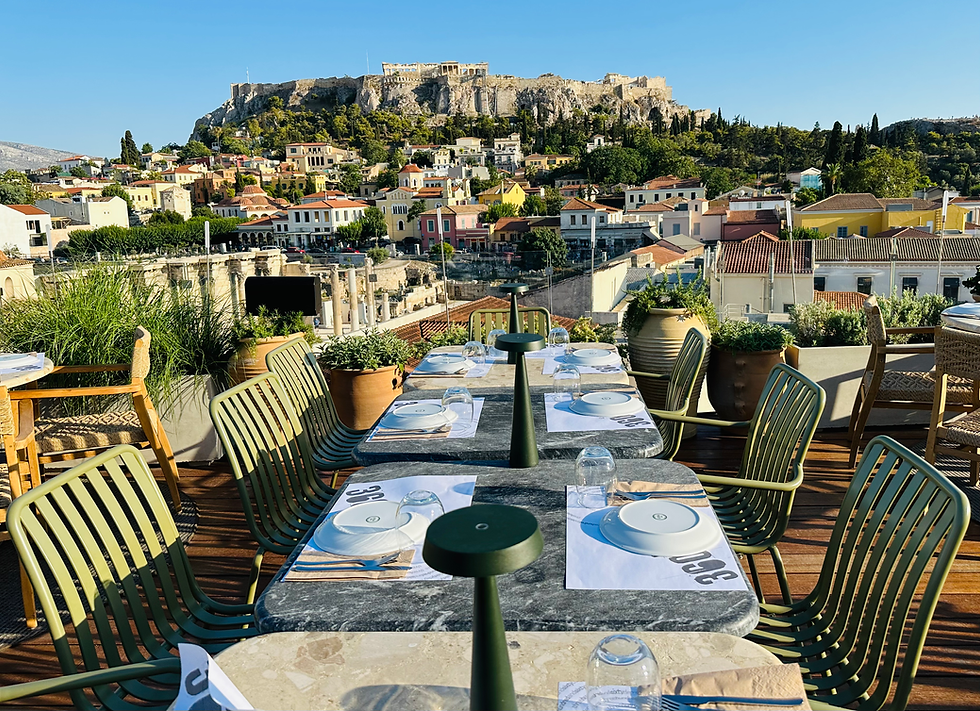What places can I visit in Greece?
- Sabine Switalla

- Jun 21, 2023
- 4 min read
Updated: May 13, 2024
Greece is home to a multitude of museums and archaeological sites scattered across the country. Although providing an exact count is challenging, Greece prides itself on a substantial number of these cultural attractions, owing to its rich historical and archaeological heritage. With over 100 archaeological sites and approximately 300 museums, there is an abundance of captivating destinations to explore during your visit. Here are some of the notable archaeological sites you shouldn't miss:

Archaeological Sites:
Acropolis of Athens: A UNESCO World Heritage site, it includes the iconic Parthenon, Erechtheion, and other ancient structures overlooking the city of Athens.
Delphi: The site of the ancient oracle and the Temple of Apollo, known for its archaeological remains and stunning mountainous setting.
Olympia: The birthplace of the Olympic Games, featuring the ruins of the ancient stadium, temples, and the Statue of Zeus, one of the Seven Wonders of the Ancient World.
Knossos: Located on the island of Crete, it is the largest Bronze Age archaeological site of the Minoan civilization, with well-preserved palace ruins.
Epidaurus: Famous for its ancient theater renowned for its excellent acoustics, it is part of a larger sanctuary dedicated to the god Asclepius.
Museums:
National Archaeological Museum, Athens: One of the world's greatest archaeological museums, housing an extensive collection of artifacts from prehistoric to late antiquity periods.
Museum of the Acropolis, Athens: Located on the southeastern slope of the Acropolis, it exhibits archaeological finds from the Acropolis site, including the renowned Parthenon Marbles.
Archaeological Museum of Delphi: Displays artifacts discovered at the Delphi site, including the famous Charioteer of Delphi and the Sphinx of Naxos.
Heraklion Archaeological Museum, Crete: Showcases Minoan artifacts, including frescoes, pottery, and the Phaistos Disk, providing insights into the Minoan civilization.
Archaeological Museum of Thessaloniki: Features artifacts from various archaeological sites in northern Greece, representing the region's history from prehistoric times to the Roman period.
Find more about Greece’s archeological sites and museums here:
How accessible are the sites and historical attractions in Greece?
The accessibility of museums and archaeological sites in Greece has seen ongoing improvement efforts. A process of enhancing accessibility by installing lifts, ramps, and signage is currently underway in many locations. As a result, some attractions are more accessible than others and may be easier to navigate for individuals with mobility challenges.
However, it's important to note that the level of accessibility can vary between sites. Before traveling, it is advisable to gather information and confirm the accessibility features of the specific site you intend to visit. This may involve contacting the site directly or referring to resources provided by the Greek Ministry of Culture and Tourism, local tourism organizations, or reliable travel guides such CareunderSun.
Overall, while progress is being made to enhance accessibility in museums and archaeological sites in Greece, it is recommended to verify the accessibility status of individual sites to ensure a smooth and enjoyable experience during your visit.
Can I rely on the information?
Occasionally, there may be instances when installations, such as lifts, are not operational. For example, the lift that allows visitors to reach the Acropolis may be out of order due to technical issues or adverse weather conditions, such as strong winds. Unfortunately, this information is not always readily available on the Acropolis page or other official sources, which means you might arrive at the Acropolis entrance only to discover that you are unable to access the top due to the lift being unavailable.
Do I get a discount if I am visiting Greek museums and archeological sites with my disabled ID?
If you are a foreign that is willing to visit Greece and you hold a Disability Card, you can present proof of identification (ID or passport) along with official documentation of your disability to enjoy free access to Greek sites and museums. As easy as that, this requirement ensures a seamless and efficient process for visitors, enabling them to fully immerse themselves in Greece's cultural treasures.
In case you still do not have a disability card, individuals with disabilities can apply for an EU Disability Card or SID-EU card online, granting them various benefits, including free access to cultural sites. This accessible application process provides a convenient avenue for individuals seeking to avail themselves of these privileges.
What are the opening hours of the attractions in Greece?
Opening hours of attractions in Greece vary depending on the site and time of year. During the peak tourist season (April to October), most attractions have extended hours, typically opening early and closing in the late afternoon or early evening. However, specific opening hours can differ between sites, so it is advisable to check official websites or contact the attraction directly for accurate and up-to-date information.
When is the best time to visit the museums and archeological sites in Greece?
Even when Museums and archaeological sites are open all over the year in Greece, we recommend you to better visit them during the low season as it can offer a more rewarding and enjoyable experience. In the low season, typically outside of peak tourist months, the number of visitors tends to decrease, resulting in fewer crowds and a more serene atmosphere. This allows you to explore and appreciate the exhibits and sites at your own pace, without feeling rushed or overwhelmed. Additionally, with fewer visitors, you may have the opportunity to engage more deeply with the places and gain a clearer view of the historical and cultural significance they hold.
Moreover, during the low season, there may be shorter wait times, making it easier to access popular attractions and ensuring a more immersive and uninterrupted encounter with the treasures of the past.




Comments